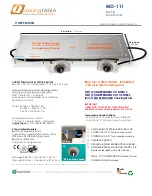
Aladdin MAXbrite Burner Operating and Safety Instructions – November 2016 3 |
P a g e
13.
Gently return gallery-mantle-chimney assembly from Step 7 to top of burner. Lock into place by turning to right
(clockwise).
CAUTION: Do not jolt the gallery-mantle-chimney assembly as mantle could break.
Never leave a burning lamp unattended. Always monitor your lamp when lit.
Use only in a well ventilated area. Avoid drafts, which may cause lamp to flicker unpredictably. (In
extremely air tight rooms, you may need to crack open a window.)
Keep combustible materials at least 36” above chimney top. Do not allow combustible materials within 18”
of lamp.
14.
Before the chimney heats up, make sure it is seated against the gallery to prevent air leaks around the chimney base.
If you purchased an optional shade, you can add it now by setting it gently in the shade holder/tripod you installed in Step
9.
Make sure the lamp is stable with the shade installed. Use only approved shades. Monitor the mantle
more carefully since over-firing may be more difficult to observe with shade installed.
15.
Turn wick up slowly until just the top half of mantle glows brightly. Allow burner to warm up for 20 minutes. Next,
adjust wick so that just ¾ of the mantle glows brightly. Lamp will soon achieve full illumination on its own. Lamp is
correctly adjusted when no yellow flame is visible and mantle is glowing brightly without any blackened or browned
spots.
Never leave a burning lamp unattended. Continually monitor your lamp while in use. Extinguish the flame
before leaving the room. The flame height changes depending on the temperature of the lamp or the room. Any lamp
that is not monitored while burning can tip over or become over-fired and flare up, creating a serious fire hazard.
Causes of over-firing
Air flow through the burner is created by heat rising through the chimney. The moving air provides oxygen to the flame
and also cools the burner. Very low flame may cause over-firing. That’s because the burner is still heated, but the smaller
flame is not moving enough air through the burner to prevent over-firing. Very high flame may cause over-firing, because
too much heat is produced.
High temperatures cause more unburned fuel to vaporize than can be consumed by the flame. The unburned fuel then
burns when it passes through the hot mantle, producing soot and carbon buildup. As the soot builds up, it restricts air
flow and lack of airflow accelerates the process of overheating.
Always operate the burner with the flame adjusted so that there is white light in the mantle, no black spots on the
mantle, no visible yellow flame and no acrid odor or smoke.
WARNING
WARNING
WARNING
WARNING
WARNING
Correctly
illuminated
mantle























